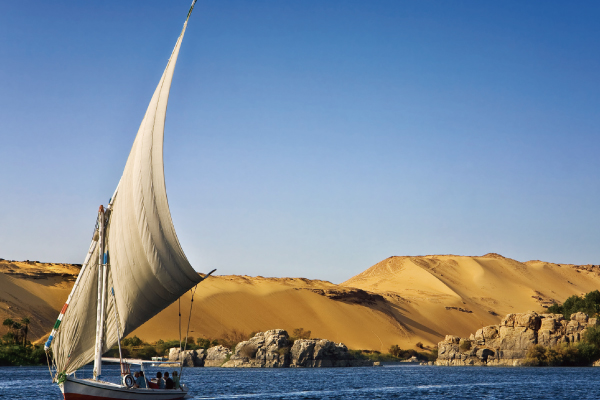
Measuring in at almost 6,853 kilometers in length, the Nile is the longest river in the world. Most people associate the Nile with Egypt, but in fact, only about 22% of the river can be found there. Perhaps this association came from the ancient Egyptians. After all, one of the world's oldest civilizations began on the banks of the Nile. The ancient Egyptians relied heavily on water from the Nile for their food. Every year between June and September, the Nile would flood. The flood produced a thick layer of black silt that was ideal for growing crops. These annual floods carried on for thousands of years until 1970, when the Egyptian government completed the Aswan Dam. The Nile also provided a valuable mode of transportation for trading with other civilizations, from Europe to Southwest Asia. It helped Egypt turn into a trading center that brought the entire ancient world together. The Nile River has two major tributaries: the White Nile and the Blue Nile. The White Nile got its name from the white clay that flows in its waters. It starts at Lake Victoria in central Africa. The Blue Nile, on the other hand, starts at Lake Tana in Ethiopia, and it joins the White Nile near the Sudanese capital of Khartoum. The Blue Nile is very important for Egyptians because it accounts for 56% of the Nile water that flows northward through Egypt and into the Mediterranean Sea. The Nile is still a fundamental part of life in Egypt. The river accounts for almost all of Egypt's drinking water. It also provides the water needed to grow food. But Egypt may be facing water shortages in the near future. Egypt's population is projected to grow over the next few decades, which will increase the demand for Nile River water. Demand will also increase in the countries where the Nile's tributaries are located, including Ethiopia and Burundi. To remedy the problem, the Egyptian government is planning to renovate the Aswan Dam and increase its water efficiency. It's also encouraging people to move inland and away from the Nile in order to reduce crowding.
全長近6,853 公里的尼羅河,堪稱全世界最長的河流。 只要提及尼羅河,多數人就會聯想到埃及,殊不知僅有22% 的尼羅河流域流經埃及而已。或許這樣的聯想來自於古埃及人。畢竟,全球最古老的文明之一起源於尼羅河河畔。古埃及人十分仰賴尼羅河來維持生計。每年六至九月,尼羅河就會開始泛濫。豐沛河水會產生一層厚實的黑色淤泥,成為適合耕種作物的肥沃土壤。每年洪水暴漲的情形維持了數千年,直到1970 年,埃及政府建造的亞斯文水壩竣工為止。 尼羅河亦為貿易運輸的珍貴管道,能讓歐洲至西南亞地區的其他文明相互往來。也讓埃及轉變為集散所有古文明的貿易樞紐。 尼羅河有兩大支流,分別是白尼羅河與藍尼羅河。白尼羅河的名稱起於常有白泥流入河水。白尼羅河的源頭始於中非的維多利亞湖,藍尼羅河的源頭則始於衣索比亞的塔納湖,並於蘇丹首都喀土穆附近,與白尼羅河匯合。對埃及人而言,藍尼羅河舉足輕重,因為往北流經埃及與流入地中海的尼羅河流量中,藍尼羅河就佔了56%。 尼羅河仍是埃及的民生基礎。埃及的飲用水幾乎全來自尼羅河,亦為灌溉作物的水源。但是不久的將來,埃及可能面臨水源短缺的問題。預計未來數十年,埃及的人口會不斷成長,屆時尼羅河的用水量亦將隨之增加。而衣索比亞與蒲隆地等尼羅河支流所在的國家,供水量的需求同樣會攀升。為了補救此問題,埃及政府預計整修亞斯文水壩以提高蓄水力。政府亦鼓勵民眾遷往遠離尼羅河的內陸地區,以改善人口稠密的情況。 |
沒有留言:
張貼留言